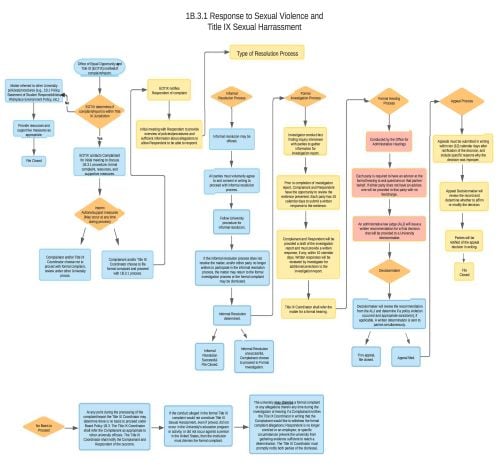1B.3.1 Response to Sexual Violence and Title IX Sexual Harassment Complaint Process

This investigation process begins with reporting. Potential complainants, students, faculty, and staff are strongly encouraged to make reports promptly of allegations of sexual violence and sexual harassment (as defined by Title IX). Any campus security authority who has been informed of allegations shall report to the Title IX Coordinator.
Office of Equal Opportunity & Title IX (EOTIX) receives a report or complaint.
- EOTIX determines if complaint/report is within Title IX jurisdiction.
- If there is no Title IX jurisdiction, the matter is referred to other University policies/procedures (e.g., 1B.1. Policy, Statement of Student Responsibilities, Workplace Environment Policy, etc.). If 1B.1, EOTIX will proceed under the 1B.1.1 process. If referred, EOTIX will still provide resources and supportive measures as appropriate and then the file is closed.
- If there is Title IX jurisdiction, EOTIX contacts Complainant for an initial meeting to discuss the 1B.3.1 Procedure, formal complaint, resources, and supportive measures.
- EOTIX will evaluate on a case-by-case basis to determine if interim actions and/or supportive measures are appropriate. EOTIX may implement interim actions and/or supportive measures at any time during the process.
The Complainant or the Title IX Coordinator choose to file a formal complaint and proceed with the 1B.3.1 process.
- EOTIX notifies Respondent that a complaint has been filed against them.
- EOTIX holds an initial meeting with Respondent to provide overview of the policies and procedures and provide Respondent with sufficient information about the allegations to allow Respondent to be able to respond.
- The investigator and the parties determine the type of resolution process. There are two types of resolution processes: Informal resolution process and formal investigation process.
Informal resolution
- Informal resolution may be offered.
- All parties must voluntarily agree to and consent in writing to proceed with the informal resolution process.
- If proceeding, EOTIX will follow University procedure for informal resolution.
- If the informal resolution process does not resolve the matter, and/or either party no longer wishes to participate in the informal resolution process, the matter may return to the formal investigation process, or the formal complaint may be dismissed.
- If successful, the informal resolution is determined, and the file is closed.
Formal investigation process
- Investigator conducts fact-finding inquiry interviews with parties to gather information to be included in an investigation report.
- Prior to completion of the investigation report, Complainant and Respondent have the opportunity to review the evidence presented. Each party has ten (10) calendar days to submit a written response to the evidence.
- Complainant and Respondent will be provided a draft of the investigation report and must provide a written response, if any, within ten (10) calendar days. Written responses will be reviewed by Investigator for additions/corrections/revisions to the investigation report.
- Title IX Coordinator shall refer the matter for a formal hearing to the Attorney General’s Office.
- The formal hearing process is conducted by the Office for Administrative Hearings. Notices will be facilitated by the Attorney General’s Office.
- If either party does not have an advisor for the formal hearing, the university will provide one to that party with no fee or charge. The role of the advisor is to conduct cross-examination, in other words, ask questions on the parties’ behalf.
- An administrative law judge (ALJ) will issue a written recommendation for a final decision to be made by a university decisionmaker.
- The decisionmaker will review the recommendation from the ALJ and determine if a policy violation occurred and appropriate sanction(s), if applicable. A written determination is sent to parties simultaneously.
- At this point in the process, both parties have the opportunity to appeal the decision by the university decisionmaker.
- If there is no appeal by either party, the file is closed.
- If an appeal is filed, it must be submitted in writing within ten (10) calendar days after notification of the decision and include specific reasons why the decision was improper.
- The appeal will be assigned to a different university decisionmaker. The decisionmaker on the appeal will review the record and determine whether to affirm or modify the decision.
- The parties will be notified of the appeal decision in writing.
- The file is closed.

